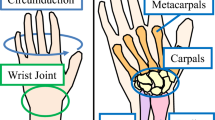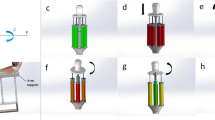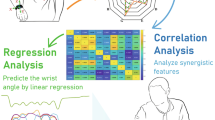Abstract
This study developed a rehabilitation system that can improve the patient care services provided by physical therapists. Wristparalyzed patients were given arbitrary force through a six-Degree of freedom (6DoF) parallel mechanism composed of six pneumatic cylinders, and recovery training was performed. Each pneumatic cylinder was used to apply force control using a pulse width modulation control, and the force of the 6DoF direction was directed to the wrist of the patient. The thrust force of each cylinder and the force of the 6DoF direction of the parallel mechanism were analyzed. The analysis results conformed well to the experimental results. The developed rehabilitation system was designed to help a physical therapist remotely treat multiple patients at the same time. To monitor the operation of the parallel mechanism of each patient’s side, a 3D computer graphic model was created through OpenGL. The movement of this model was investigated to further examine the movement of the 6DoF direction of the parallel mechanism. Results confirmed that both movements can be controlled synchronously.
Similar content being viewed by others
References
http://www.nedo.go.jp/content/100089429.pdf.
R. Shirakawa et al., Therapeutic effects of power assist training combined with biofeedback on hemiplegia by therapeutic exercise machine, 1st World Congress of the International Society of Physical and Rehabilitation Medicine Abstract (2001) 134.
D. Stewart, A platform with six degrees offreedom, Proceedingsof the Institution of Mechanical Engineers, 180 (1-15) (1965) 371–386.
C. Innocenti and V. P. Castelli, Direct position analysis of the stewart platform mechanism, Mech. Mach. Theory, 25 (6) (1990) 611–621.
F. Pierrot. M. Uchiyama, P. Dauchez and A. Fournier, A new design of a 6-DOF parallel robot, Journal of Robotics and Mechatronics, 2 (4) (1991) 308–315.
I. Y. Lee, Trend of hydraulic servo control technology-topics on automobile application, Journal of the Korea Society for Power System Engineering, 2 (1) (1998) 10–16.
H. Funahashi, Parallel mechanisms as a new robotic mechanism, Journal of the Robotics Society of Japan, 10 (6) (1992) 699–704.
L.-W. Tsai, Robot analysis, John Wiley & Sons Inc. (1999) 116.
M. T. Kandakure, V. G. Gaikar and A. W. Patwardhan, Hydrodynamic aspects of ejectors, Chemical Engineering Science, 60 (3) (2005) 6391–6402.
F. Sarah, J. Karl-Peter and T. Ansgar, Test rig for the hardware-in-the-loop simulation of mechatronic axles, 9th IFK 2014, Aachen, Germany (2014) 366–377.
T. Noritsugu and M. Takaiwa, Motion control of parallel link manipulator using disturbance observer, Proceeding of the Japan USA Symposium on Flexible Automation, 1 (1996) 173–180.
M. Takaiwa and T. Noritsugu, Development of humanrobot haptic interface using pneumatic parallel manipulator, Proceedingsof the 4th JFPS Int. Symposium. on Fluid Power (1999) 181–186.
Y. Tanaka, T. Nakajima and T. Sawada, Desktop type of force display using pneumatic parallel mechanism, Proceed ings of the Fourth International Symposium on Fluid Power Transmission and Control (2003) 267–271.
Y. Hitaka, Y. Tanaka and J. Ishii, Development of force feedback system with pneumatic parallel mechanism, Proceedings of the 13th International Conference on Mechatronics Technology, ICMT2009. Cebu, Philippines, October 20-23 (2009).
K. Sugimoto, Force analysis for parallel manipulators, Journal of the Robotics Society of Japan, 10 (6) (1992) 706–708.
K. Kosuge, O. Minoru, H. Kawamata, T. Fukuda, T. Kozuka and T. Mizuno, Input/output analysis of parallel link manipulator, Transactions of the JSME60 (675) (1994) 134–140.
C. Zhu, J. Wang and Z. Chen, Dynamic characteristic parameters identification analysis of a parallel manipulators, Journal of Mechanical Science and Technology, 28 (12) (2014) 4833–4840.
Y. Tanaka, I. Yokomichi and J. Ishii, 3-D visualization on workspace of parallel mechanism, JSME Journal of Advanced Mechanical Design, Systems and Manufacturing, 3 (1) (2009) 22–33.
Y. Tanaka, I. Yokomichi and J. Ishii, Workspace search of hydraulic parallel manipulators, Proceedings of the 5th International Fluid Power Conference, IFK2006, Aachen, Germany (2006) 237–248.
M. Griffs and J. Duffy, A forward displacement analysis of a class of stewart platforms, Journal Robotic Systems, 6 (6) (1989) 25–28.
Y. Tanaka, I. Yokomichi and J. Ishii, Posture measurement of a parallel manipulator, Proceedings of the International Conference on Manufacturing Machine Design and Tribology, ICMDT2005, Seoul, Korea, June 5-7 (2005).
K. Tokoi, OpenGLIntroductiontodue to the GLUT, Kogakusya, ISBN4-7775-1134-0 (2005).
Jay Lee, Apply force/torques sensors to robotic application, Tech. Rep. Soc. Manuf. Eng., Ms-86-896 (1986) 189–194.
K. Ogata, K. Kashiwagi and K. Ono, Force sensor, Journal of the Robotics Society of Japan, 6 (9) (1991) 759–765.
Y. Tsumaki, H. Naruse, D. N. Nenchev and M. Uchiyama, Design of a compact 6-DOF haptic interface, Proceeding of ICRA (1998) 2580–2585.
Author information
Authors and Affiliations
Corresponding author
Additional information
Yoshito Tanaka received his Ph.D. degree in Engineering from Kyushu University, Japan in 1982. From 1969 to 2000, he worked on an electro-hydraulic servo system at the Mechanical Research Laboratory of Hitachi, Ltd. Since 2000, he has been a professor at the Department of Control and Information Systems Engineering, Kitakyusyu National College of Technology, Japan. He is also a professor of Intelligent Mechanical Engineering at the Department of Engineering, Fukuoka Institute of Technology, Japan, since 2009. He has been part of the Korea Brain Pool Researcher of the Korea Institute Machinery and Materials (KIMM) since 2014. His research interests include mechanical dynamics, automatic control, and application of parallel mechanism.
So-Nam Yun received his Ph.D. degree from Pukyong National University in 1994. He is a principal researcher of the Extreme Mechanical Engineering Research Division of KIMM and a professor of Plant System and Machinery at Korea University of Science and Technology. His research interests include smart actuators, hydraulic-pneumatic valves, simulator, and hydraulic devices for deep-sea submersibles.
Yutaka Tanaka received his Ph.D. degree in Engineering from Tokyo Institute of Technology, Tokyo, Japan, in 1991. From 1985 to 1991, he worked on an electrohydraulic servo system in the Precision and Intelligence Laboratory of Tokyo Institute of Technology, Tokyo, as a research associate. Since 1991, he has been an associate professor of Mechanical Engineering at the College of Engineering, Hosei University, Tokyo. He is also a professor of Engineering and Design at the Faculty of Engineering and Design, Hosei University, since 2002.
Rights and permissions
About this article
Cite this article
Tanaka, Y., Yun, SN. & Tanaka, Y. Development of synchronized control system through a pneumatic parallel mechanism and its 3D CG model. J Mech Sci Technol 30, 397–403 (2016). https://doi.org/10.1007/s12206-015-1244-1
Received:
Revised:
Accepted:
Published:
Issue Date:
DOI: https://doi.org/10.1007/s12206-015-1244-1




